So, nu? (I mean… So, omicron?)
Tagged:COVID
/
MathInTheNews
/
Statistics
There’s a new SARS-CoV2 variant. How bad does it look? Nobody really knows, but it’s got the potential to be very, very bad.
So, nu?
The next letter of the Greek alphabet available was ν (nu). I had a whole raft of jokes based on the Yiddish expresson “so, nu?” meaning something like “so, go on and tell me more?” “So, nu?” is never going to be a COVID-19 joke, more’s the pity. Sort of.
The next letter after that in the Greek alphabet is ξ (xi, or as we were taught in my mis-spent youth, chsi). Alas, there is a certain autocrat who might take umbrage at the use of his family name for a virus originating in his country, especially when his propaganda apparatus is pushing the story that SARS-CoV2 originated in America instead. No point in poking the dragon with a sharp stick, unless you have good plans for what to do after that.
So… ο (omicron) it is, then… according to the World Health Organization’s Technical Avisory Group (yes, it’s really called the “WHO TAG team”). [1]
Our safari guide
Having been deprived of our opportunity for humor, let’s get down to business. Our safari guide in these matters is Your Local Epidemiologist, a.k.a. Katelyn Jetelina. [2] She’s a professor in the department of epidemiology at the University of Texas Health Science Center at Houston, with a PhD in epidemiology & biostatistics, and is an editor of BMJ. Ok, she’s convinced me to listen. (Feel free to make up your own jokes about “epidemiologists going viral”. I’m still grumpy at being deprived of “so, nu?”)
 She posted yesterday about the Omicron variant. [3] Let’s go
through what she wrote, see what we can simplify, and examine her primary sources to see
if we can add anything of our own. (Hint: Not much. She’s good. Really, really good.)
She posted yesterday about the Omicron variant. [3] Let’s go
through what she wrote, see what we can simplify, and examine her primary sources to see
if we can add anything of our own. (Hint: Not much. She’s good. Really, really good.)
Where did this thing come from?
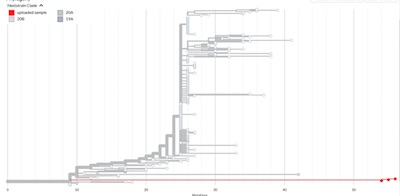 It’s been given the name B.1.1.529, meaning it’s a descendant of one of the very early
B.1.1 variants. It is, in particular, not a descendant of the more recent Delta
variant. The only public cladogram I can find is the blurry one shown here (click to
embiggen). [4] (The
relevant PANGO/NextStrain servers
are not responding to me when I try to generate my own, probably because every scientist
on the planet is asking them questions right now!)
It’s been given the name B.1.1.529, meaning it’s a descendant of one of the very early
B.1.1 variants. It is, in particular, not a descendant of the more recent Delta
variant. The only public cladogram I can find is the blurry one shown here (click to
embiggen). [4] (The
relevant PANGO/NextStrain servers
are not responding to me when I try to generate my own, probably because every scientist
on the planet is asking them questions right now!)
So let me attempt to guide us through this a bit:
- Everything starts with the original Wuhan virus.
- The horizontal axis is the number of mutations, increasing to the right.
- When a new strain occurs, the mutations are compared to the existing strains to tell us where to put it into the tree, i.e., the parental strains from which it evolved. This is all rule-based, i.e., nobody’s making decisions here that might be biased.
- The assigned name is generated by walking the tree, e.g., our boy today being called B.1.1.529 means it’s one of many variants of B.1.1, which was a very early variant near the root of the tree.
- The red line is 3 samples of the the Omicron variant. NB: Pay careful attention to how high up the tree it branches off! It does not branch of Delta, which would be somewhere up at the top center of the plot. Instead, it’s a whole pile of mutations on top of one of the ancestral B.1.1 strains.
It looks like somebody caught an older version of COVID-19 (which is less likely with Delta in the wind, but still possible). If this person were immunocompromised, then they wouldn’t be able to clear the virus for a long time. So the virus just hung around in their body, mutating, and mutating, and mutating…
Et voila: Omicron! It just has a boatload of mutations, making it quite different from the other strains. What will turn out to be important is where those mutations occur, and what they do.
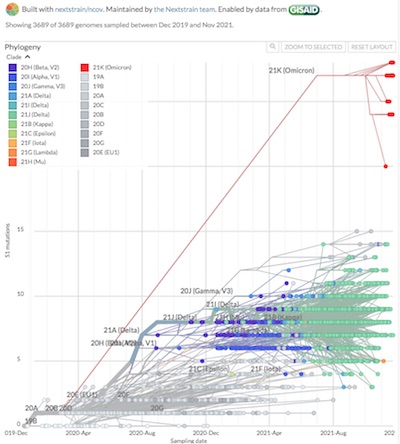 Addendum 2021-Nov-29: I finally got through to the nextstrain.org servers. Here’s an
updated cladogram
– with slightly different criteria, looking at SARS-CoV2 strains in Africa –
but which shows how Omicron is very
different from other strains, not a descendant of Delta, and apparently a big heaping
pile of mutations piled on an earlier strain. (Click to embiggen.)
Addendum 2021-Nov-29: I finally got through to the nextstrain.org servers. Here’s an
updated cladogram
– with slightly different criteria, looking at SARS-CoV2 strains in Africa –
but which shows how Omicron is very
different from other strains, not a descendant of Delta, and apparently a big heaping
pile of mutations piled on an earlier strain. (Click to embiggen.)
It really looks as if it incubated forever in an immunocompromised person who couldn’t clear the infection as it kept mutating… and mutating… and mutating.
But is it a threat?
According to the WHO TAG team, possibly. They’ve designated it a “variant of concern” (VOC), which is what we named things like Delta. The crucial questions are, in a world where Delta is now almost the only SARS-CoV2 strain worth worrying about:
- Does it transmit more than Delta? (If not, Delta will out-compete it; if so, it will out-compete Delta.)
- Does it cause more severe disease than Delta? (If not, then at least it’s less bad than Delta and may give partial immunity to Delta; if so, then we want to avoid it at all costs.)
- Does it evade current vaccines? (If not, just push harder on getting people vaccinated and boosted; if so, then we need a vaccine specific to Omicron & possibly Delta also as soon as possible and then get everybody re-vaccinated! Imagine how much fun that will be…)
What’s the evidence that any of those are issues? Consider where the mutations in the spike protein lie. Here our primary informant is Jeffrey Barrett, CSO of Nightingale Health and leading the COVID-19 genomics issue at the Sanger Institute. He’s classified them (click to view the entire table in the tweet, not the cut off version here):
His explanations of the details of that table in following tweets are quite worth reading, explaining in detail why each color is bad news. But for now, let’s go with Jetelina’s summary:
- Red: Known bad. These are mutations seen in previous VOC’s that have made the virus more deadly. Just what we need, eh?
- Purple: New mutations not seen in the wild, but in vitro data suggest they might be bad.
- Yellow: They’re near an important site on the protein, but nobody knows what they do.
- Blue: Never seen before, no lab data, nobody knows.
- Green: Mutation seen lots of times before, basically fixed in the genome all the way back to 2020. Nothing to worry about.
Note there is not much green in the list! Some of them are in important places where vaccine-induced antibodies bind, and thus could muck up vaccine immunity. Others are in places like the receptor binding domain (RBD) that could make it stick better to the human ACE2 receptor, and thus become more virulent. Yes, those statements involve the modal word “may”, but they still make everybody queasy at the number of gambles being taken.
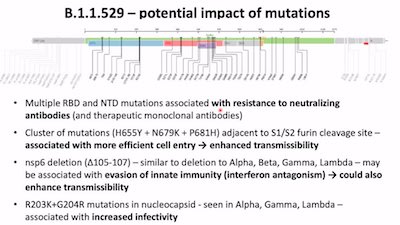 Jetelina quotes this slide from a video presentation by the South Africa Health Ministry.
(This is extremely early data; we don’t have the actual slides, and are reduced to
YouTube screen scrapes! Click to embiggen.) They show where the mutations lie along the
sequence of the spike protein, and color the regions by the function of that particular
domain: NTD, RBD, S1/S2 furin cleavage site, a deletion characteristic of evading the
innate immune system, and some other junk associated in other variants with increased
infectivity.
Jetelina quotes this slide from a video presentation by the South Africa Health Ministry.
(This is extremely early data; we don’t have the actual slides, and are reduced to
YouTube screen scrapes! Click to embiggen.) They show where the mutations lie along the
sequence of the spike protein, and color the regions by the function of that particular
domain: NTD, RBD, S1/S2 furin cleavage site, a deletion characteristic of evading the
innate immune system, and some other junk associated in other variants with increased
infectivity.
All that together, in one viral package. I do not like this. Not at all.
Sure, we’re gonna have to spend serious time and effort understanding what all those gizmos do… but what are the chances they’re mostly benign? Not much, I think.
Some empirical data
Ok, enough noodling around with genomic information that might be bad. Let’s look at what it’s actually been seen to do in South Africa.
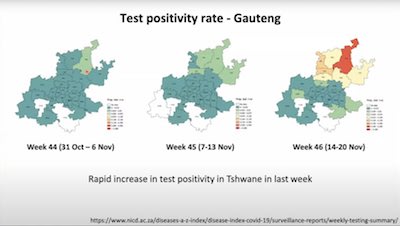 Jetelina points us at this slide from the South African National Institute for
Communicable Diseases (NICD). Note that in the Gauteng region (top right), positive test
rates went from 1% to 30%, in two weeks! That’s… terrifyingly fast.
Jetelina points us at this slide from the South African National Institute for
Communicable Diseases (NICD). Note that in the Gauteng region (top right), positive test
rates went from 1% to 30%, in two weeks! That’s… terrifyingly fast.
So that’s one bit of evidence in favor of increased infectiousness for Omicron.
Now, to be sure, it’s likely the population there is largely unvaccinated. This is the cost of vaccine inequity: we leave the developing world defenseless, and in the process of being victims of SARS-CoV2 they become breeding grounds for variants that can come back and kill the rest of humanity. If it’s not enough to make the moral argument that we should all be each other’s keepers, then pay attention to the selfish argument that you don’t want variants breeding and coming back to kill you.
The estimates from modeler JPWeiland say that while Delta is 70% more transmissible than SARS-CoV2 classic, Omicron appears to be 700% more transmissible. When you compare that with the share of sequenced cases in South Africa, that number is about right. Jetelina shows us this (approximated) graph from John Burn-Murdoch, chief data reporter at the very pink Financial Times (click to embiggen). Whatever’s going on, Omicron is spreading more rapidly than Delta, at least in a largely unvaccinated population.
I haven’t tried to fit a logistic curve like these guys have, because the data isn’t out yet. But if they’re even mostly right, Omicron is spreading fast.
Conclusion: Omicron is very likely to be more infectious than Delta.
Some good(?) news
Jetelina points out 3 potentially good signs:
- Omicron can be distinguished from other variants by a PCR test, instead of requiring a sequencing machine.
- We’ve seen it very, very early and have a little bit of time to figure out what to do. The South Africans have been completely amazing and deserve our respect and gratitude.
-
mRNA vaccines can be rapidly “reprogrammed” to make new proteins. (Though manufacturing, distribution, and getting shots in arms are other matters, as we discovered to our sorrow this year.)
But people are estimating 6 weeks to do the mini-trial, then a week or so for the FDA & CDC to approve/EUA it. In an article today from NPR [5], Moderna said it was working on booster vaccines anticipating mutations like Omicron, and is ramping up efforts on a Delta-specific and Omicron-specific vaccine; Pfizer and BioNTech said once they have enough information in the next 2 weeks, they could have Omicron boosters ready to ship in 100 days.
So maybe we can fight it with vaccines… if people will take the vaccines!
The Weekend Conclusion
- It’s important to protect the immunocompromised members of our community! It’s not just the moral thing to do, but it also is good for everyone to prevent the occurrence of sources of mutations.
- For the same reason, it’s important for everybody to get vaccinated! In Jetelina’s
words:
Get vaccinated. Get boosted. Ventilate spaces. Use masks. Test if you have symptoms. Isolate if positive. And encourage others to do the same.
- The crucial questions are, as above:
- Does it transmit more than Delta?
- Does it cause more severe disease than Delta?
- Does it evade current vaccines?
We should fervently hope the answers to all 3 of those questions are “no”. Otherwise, we’ll be breaking out the Omicronomicon.
Addendum 2021-Nov-28: ZDogg MD’s Omicron Opinion
ZDoggMD (a.k.a. Dr. Zubin Damanya) weighed in with this video on Omicron. He and I don’t always agree: he’s more cavalier about no mandates & letting unvaccinated people stay unvaccinated in spite of the damage to the healthcare system; he’s more cautious about advising masks; he wants more finely sliced advice on boosters; he’s much more interested in meditation… and so on. But we do agree that vaccination is the best policy. He’s much better at capturing the “story” that hooks people’s interest, whereas I’m just annoyed by “story”.
So basically he’s a good, responsible doctor who is a good science and medical advice communicator. He covers most of the points about Omicron that are relevant. The crucial questions are still the 3 questions above.
For people who need to see a human face and hear advice in the form of a story, this is as good a starting place as any. Probably better.
Addendum 2021-Nov-29: Your Local Epidemiologist, Again

 Katelyn Jetelina, writing in her blog Your Local Epidemiologist, has now updated twice
on Omicron. [6] [7] When an
epidemiologist starts offering you daily updates, it’s time to pay attention. (As we used
to say in my lab: when the chemists are running away… try to keep up!)
Katelyn Jetelina, writing in her blog Your Local Epidemiologist, has now updated twice
on Omicron. [6] [7] When an
epidemiologist starts offering you daily updates, it’s time to pay attention. (As we used
to say in my lab: when the chemists are running away… try to keep up!)
She points us at the fact that the CDC has issued an Omicron update [8]. It’s nice to see that the CDC expressed gratitude to the South African government and scientists for catching this so early and being transparent with their data. (It’s really unfortunate that the rest of the world is punishing them with travel bans, a severe disincentive to good behavior in the future!) The CDC’s advice:
We know what it takes to prevent the spread of COVID-19. CDC recommends people follow prevention strategies such as wearing a mask in public indoor settings in areas of substantial or high community transmission, washing your hands frequently, and physically distancing from others. CDC also recommends that everyone 5 years and older protect themselves from COVID-19 by getting fully vaccinated. CDC encourages a COVID-19 vaccine booster dose for those who are eligible.
There were a number of border closures today, including Japan and Israel. Your humble Weekend Editor would like to remind everyone of Your Local Epidemiologist’s comments on the ineffectiveness of border closures from 2021-Nov-26 [3]:
Travel bans are not evidence-based: It may seem like travel bans for individual countries are a necessary step, but I cannot stress enough that they do not work. For example, we had a travel ban with China in March 2020, only to be infiltrated with a European strain. Travel bans are a political move; a tool to show the public that the government is responding. Travel bans can do a lot of damage, though, like perpetuate disease related stigma. This variant has already spread. A travel ban is not an evidence-based solution unless you stop all travel from every country.
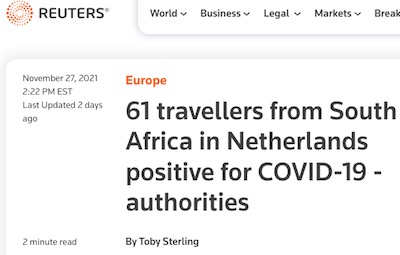 One disturbing anecdote from YLE: Reuters reports that in Amsterdam, 2 planes from South
Africa landed and all 600 passengers were tested. 61 came back positive, or about 10%
positive. [9] As if that’s not sufficiently stupefying, all
tested negative when they boarded the flight. It is not yet known how many of those were
Omicron infections, or how many passengers were fully vaccinated. The Dutch government
responded the same day with a complete ban on travel from South Africa, despite what we
now know about the uselessness of travel bans. (Though travel bans on unvaccinated
people might make sense?)
One disturbing anecdote from YLE: Reuters reports that in Amsterdam, 2 planes from South
Africa landed and all 600 passengers were tested. 61 came back positive, or about 10%
positive. [9] As if that’s not sufficiently stupefying, all
tested negative when they boarded the flight. It is not yet known how many of those were
Omicron infections, or how many passengers were fully vaccinated. The Dutch government
responded the same day with a complete ban on travel from South Africa, despite what we
now know about the uselessness of travel bans. (Though travel bans on unvaccinated
people might make sense?)
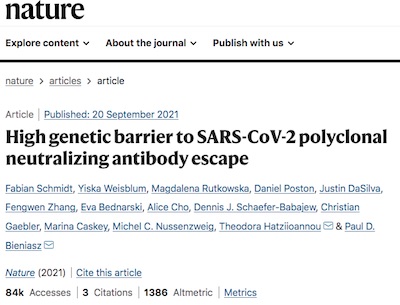 Let’s turn to the subject of whether Omicron might evade vaccines, given that it has 32(ish)
mutations in the spike protein with about half of them in the receptor-binding domain
(RBD). Jetelina points us to an article in Nature pointing out there is an upper limit
to the number of spike protein mutations a virus can have, before it no longer binds well
to its target ACE2 receptor.
Let’s turn to the subject of whether Omicron might evade vaccines, given that it has 32(ish)
mutations in the spike protein with about half of them in the receptor-binding domain
(RBD). Jetelina points us to an article in Nature pointing out there is an upper limit
to the number of spike protein mutations a virus can have, before it no longer binds well
to its target ACE2 receptor.
Basically, this is not your immune system’s first rodeo: it knows a thing or two about how to cope with mutations in infectious pathogens. It generates lots of different (polyclonal) antibodies to the spike protein. In order to evade all of those, the spike protein would have to change so much it might not be able to bind to the ACE2 receptor in your lungs any more. Vaccine efficacy might be reduced, sure; it will almost certainly not be eliminated. Vaccines are still good, useful, and something you should do.
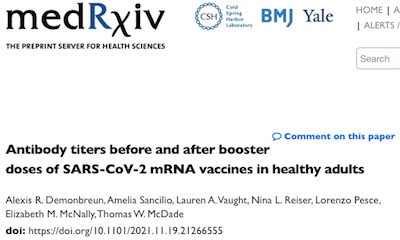 Boosters not only raise the number of antibodies, but also the diversity of antibodies
to various spots on the spike protein. [11] So it’s
important to get a booster once you’re eligible: you not only get short- to
intermediate-term increased immunity from antibodies, you also get long-term increased
immunity because your antibodies check more carefully for mutations in the spike protein,
giving broader immunity to variants. That’s in addtion to antibody maturation, where
your immune system refines the antibodies over time to get better and better; your memory
B-cells are busy.
Boosters not only raise the number of antibodies, but also the diversity of antibodies
to various spots on the spike protein. [11] So it’s
important to get a booster once you’re eligible: you not only get short- to
intermediate-term increased immunity from antibodies, you also get long-term increased
immunity because your antibodies check more carefully for mutations in the spike protein,
giving broader immunity to variants. That’s in addtion to antibody maturation, where
your immune system refines the antibodies over time to get better and better; your memory
B-cells are busy.
 And if all that doesn’t turn out to be enough, the mRNA vaccines can be modified quickly
(though getting them manufactured, purchased, distributed, and into arms is a very gnarly
problem we fought through earlier this year, with difficulty). For example, Moderna
recently issued a press release [12] on their strategy for
variants in general and Omicron in particular:
And if all that doesn’t turn out to be enough, the mRNA vaccines can be modified quickly
(though getting them manufactured, purchased, distributed, and into arms is a very gnarly
problem we fought through earlier this year, with difficulty). For example, Moderna
recently issued a press release [12] on their strategy for
variants in general and Omicron in particular:
- They’ve tested higher doses of the original vaccine (100μg) in a booster. Tests are underway to see if sera from high booster recipients are active against Omicron.
- They have 2 multi-valent booster candidates already in clinical trials:
- mRNA-1273.211 was originally started for the Beta variant, but Beta has many mutations in common with Omicron.
- mRNA-1273.213 was originally designed against both Beta and Delta, but also has a number of mutations covered that occur in Omicron.
- Sera from subjects in those trials will be tested against Omicron samples when available.
- They’re working furiously on an Omicron-specific booster, mRNA-1273.529. They seem to be able to go from initial knowledge of the sequence to clinical testing in 60-90 days. (I cannot emphasize enough: this is a stupendous improvement. Previous vaccines would take years to get to clinical trials.)
So there are sensible defenses being prepared.
Jetelina’s closing words:
Bottom Line: Our immune system is an incredible, beautiful, complex, and adaptive system. We also have thousands of scientists around the world working on our questions and on solutions if we need them. Do not delay your booster appointment. Don’t delay your 5-11 year olds second shot. Our house is currently on fire and we need to respond before Omicron has the potential to fuel it.
Addendum 2021-Dec-01: Omicron in the US
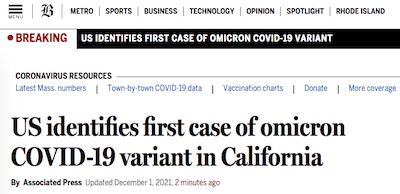 Someone has found a copy of the Omicronomicon,
and begun reading aloud. From the venerable Globe today comes news that the first case
of Omicron has been identified in California. [12]
Someone has found a copy of the Omicronomicon,
and begun reading aloud. From the venerable Globe today comes news that the first case
of Omicron has been identified in California. [12]
Fortunately for the rest of us, the individual was a recent arrival from South Africa. That’s fortunate, for some value of “fortunate”, because: (a) arrivals from South Africa are probably pretty heavily scrutinized right now, and (b) Omicron does not appear to be in community spread in the US (yet!).
The dreary truth:
Officials said those measures would only “buy time” for the country to learn more about the new variant and to take appropriate precautions, but that given its transmissibility its arrival in the U.S. was inevitable.
Notes & References
1: WHO Technical Advisory Group, “Classification of Omicron (B.1.1.529): SARS-CoV-2 Variant of Concern”, World Health Organization, 2021-Nov-26. ↩
2: Oddly, it turns out that in my neighborhood, we have a “friendly local virologist.” She lives next door. I never thought that would be a significant fact, until the pandemic. ↩
3: K Jetelina, “New Concerning Variant: B.1.1.529”, Your Local Epidemiologist blog, 2021-Nov-26. ↩
4: T Peacock, “B.1.1 decendant associated with Southern Africa with high number of Spike mutations”, PANGO Designations at Github, issue 343, 2021-Nov-23, retrieved 2021-Nov-27. ↩
5: D Jones, “How vaccine makers plan to address the new COVID-19 omicron variant”, NPR, 2021-Nov-27. ↩
6: K Jetelina, “Omicron Update: Nov 27”, Your Local Epidemiologist blog, 2021-Nov-27. ↩
7: K Jetelina, “Go get your vaccine, especially with Omicron”, Your Local Epidemiologist blog, 2021-Nov-29. ↩
8: CDC Media Relations, “CDC Statement on B.1.1.529 (Omicron variant)”, US Centers for Disease Control, 2021-Nov-26. ↩
9: T Sterling, “61 travellers from South Africa in Netherlands positive for COVID-19 -authorities”, Reuters, 2021-Nov-27. ↩
10: F Schmidt, et al., “High genetic barrier to SARS-CoV-2 polyclonal neutralizing antibody escape”, Nature, 2021-Sep-20. DOI: 10.1038/s41586-021-04005-0. ↩
11: A Demonbreun, et al., “Antibody titers before and after booster doses of SARS-CoV-2 mRNA vaccines in healthy adults”, pre-print on medRχiv, 2021-Nov-21. DOI: 10.1101/2021.11.19.21266555. ↩
12: C Hussey & L Talukdar, “Moderna Announces Strategy to Address Omicron (B.1.1.529) SARS-CoV-2 Variant”, Moderna Press Releases, 2021-Nov-26. ↩
12: Associated Press, “US identifies first case of omicron COVID-19 variant in California”, Boston Globe, 2021-Dec-01. ↩

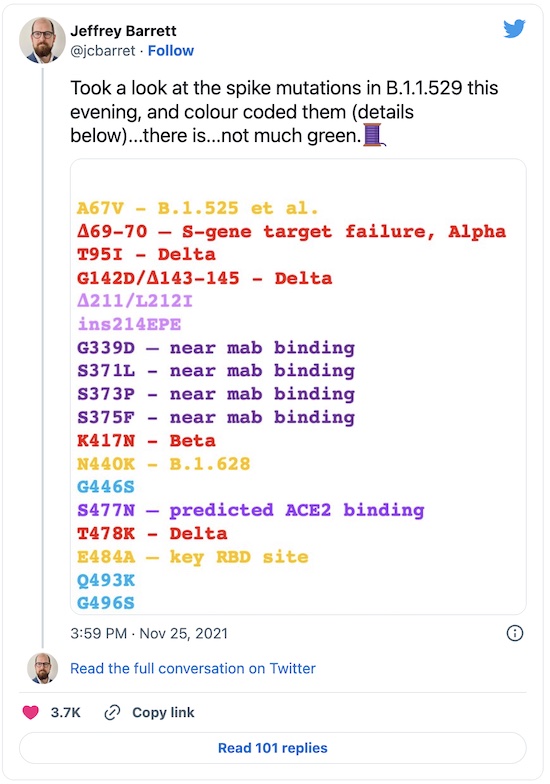
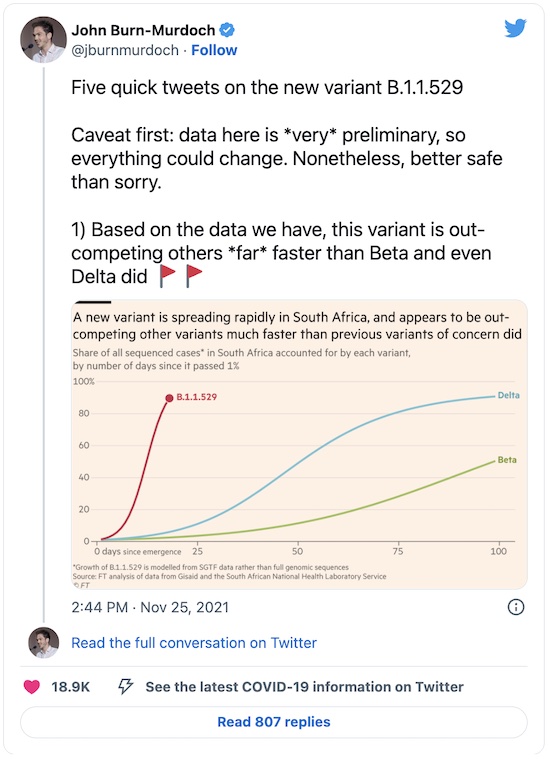
Gestae Commentaria
Comments for this post are closed pending repair of the comment system, but the Email/Twitter/Mastodon icons at page-top always work.